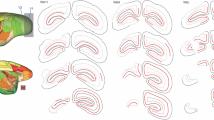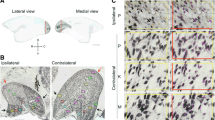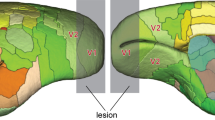Summary
Previous studies indicate that neurons in the cat's posteromedial lateral suprasylvian (PMLS) visual area of cortex show physiological compensation after neonatal but not adult damage to areas 17, 18, and 19 of the visual cortex (collectively, VC). Thus, VC damage in adults produces a loss of direction selectivity and a decrease in response to the ipsilateral eye among PMLS cells, but these changes are not seen in adult cats that received VC damage as kittens. This represents compensation for early VC damage in the sense that PMLS neurons develop properties they would have had if there had been no brain damage. However, this is only a partial compensation for the effects of VC damage. A full compensation would involve development of properties of the VC cells that were removed in the damage. The present study investigated whether this type of compensation occurs for detailed spatial- and temporal-frequency processing. Single-cell recordings were made in PMLS cortex of adult cats that had received a VC lesion on the day of birth or at 8 weeks of age. Responses to sine-wave gratings that varied in spatial frequency, contrast, and temporal frequency were assessed quantitatively. We found that the spatial- and temporal-frequency processing of PMLS cells in adult cats that had neonatal VC damage were not significantly different from PMLS cells in normal cats. Therefore, there was no evidence that PMLS cells can compensate for VC damage by developing properties that are better than normal and like those of the striate cortex cells that were damaged.
We also assessed the effects of long-term VC damage in adult cats to determine whether the normal properties seen in cats with neonatal VC damage represent a compensation for abnormalities in PMLS cortex present after adult damage. In a previous study, we found that acute VC damage in adult cats has small but reliable effects on maximal response amplitude, maximal contrast sensitivity, and spatial resolution (Guido et al. 1990b). In the present study, we found that long-term VC damage in adult cats does not increase these abnormalities as a result of secondary degenerative changes. In fact, the minor abnormalities that were present after an acute VC lesion were virtually absent following a long-term adult lesion, perhaps because they were due to transient traumatic effects. Therefore, there was little evidence for abnormalities in spatial- or temporal-frequency processing following long-term adult VC damage for which PMLS cells might show compensation following long-term neonatal damage.
Our results thus indicate that there is little or no difference in the spatial- or temporal-frequency processing of PMLS cells in normal cats and cats with long-term VC damage received early in life or as adults. These findings are discussed in relation to the inputs to PMLS cortex and to the behavioral abilities of cats with VC damage at different ages. The implications for under-standing the role of lateral suprasylvian visual cortex in behavioral recovery from VC damage is considered.
Similar content being viewed by others
References
Baumann TP, Spear PD (1977a) Evidence for recovery of spatial pattern vision by cats with visual cortex damage. Exp Neurol 57:603–612
Baumann TP, Spear PD (1977b) Role of the lateral suprasylvian visual area in behavioral recovery from the effects of visual cortex damage in cats. Brain Res 138:445–468
Belleville S, Wilkinson F (1987) The effect of neonatal visual cortex damage on vernier acuity and resolution acuity in cats. Soc Neurosci Abstr 13:1243
Berkley MA, Sprague JM (1979) Striate cortex and visual acuity functions in the cat. J Comp Neurol 187:699–702
Callahan EC, Tong L, Spear PD (1984) Critical period for the marked loss of retinal X-cells following visual cortex damage in cats. Brain Res 323:302–306
Cornwell P, Payne B (1989) Visual discriminations by cats given lesions of visual cortex in one or two stages in infancy or in one stage in adulthood. Behav Neurosci 103:1191–1199
Cornwell P, Herbein S, Corso C, Eskew R, Warren JM (1989) Selective sparing after lesions of visual cortex in newborn kittens. Behav Neurosci 103:1176–1190
Di Stefano M, Morrone MC, Burr DC (1985) Visual acuity of neurones in the cat lateral suprasylvian cortex. Brain Res 331:382–385
Doty RW (1961) Functional significance of the topographical aspects of the retinocortical projection. In: Jung R and Kornhuber H (eds) Neurophysiologie und Psychophysik des Visuellen Systems. Springer, Berlin Heidelberg New York, pp 228–247
Gizzi MS, Katz E, Movshon JA (1990) Spatial and temporal analysis by neurons in the representation of the central visual field in the cat's lateral suprasylvian visual cortex. Visual Neurosci 5:463–468
Guedes R, Watanabe S, Creutzfeldt OD (1983) Functional role of association fibers for a visual association area: the posterior suprasylvian sulcus of the cat. Exp Brain Res 49:13–27
Guido W, Spear PD, Tong L (1990a) Functional compensation in the lateral suprasylvian visual area following bilateral visual cortex damage in kittens. Exp Brain Res 83:219–224
Guido W, Tong L, Spear PD (1990b) Afferent bases of spatial and temporal-frequency processing by neurons in the cat's posteromedial lateral suprasylvian cortex: effects of removing areas 17, 18, and 19. J Neurophysiol 64:1636–1651
Kalil RE, Tong L, Spear PD (1991) Thalamic projections to the lateral suprasylvian visual area in cats with neonatal or adult visual cortex damage. J Comp Neurol 314:512–525
Lehmkuhle SE, Kratz KE, Sherman SM (1982) Spatial and temporal sensitivity of normal and amblyopic cats. J Neurophysiol 48:372–387
Maffei L, Fiorentini A (1973) The visual cortex as a spatial frequency analyzer. Vision Res 13:1255–1267
Morrone MC, Di Stefano M, Burr DC (1986) Spatial and temporal properties of neurons of the lateral suprasylvian cortex of the cat. J Neurophysiol 56:969–986
Movshon JA, Thompson ID, Tolhurst DJ (1978) Spatial and temporal contrast sensitivity of neurones in areas 17 and 18 of the cat's visual cortex. J Physiol (Lond) 283:101–120
Otsuka R, Hassler R (1962) Uber Aufbau und Gliederung der corticalen Sehsphare bei der Katze. Arch Psychiatry Z Neurol 203:212–234
Palmer LA, Rosenquist AC, Tusa RJ (1978) The retinotopic organization of lateral suprasylvian visual areas in the cat. J Comp Neurol 177:237–256
Payne BR, Conners C, Cornwell P (1991) Survival and death of neurons in cortical area PMLS after removal of areas 17, 18, and 19 from cats and kittens. Cerebral Cortex 1:469–491
Robson JG, Tolhurst DJ, Freeman RD, Ohzawa I (1988) Simple cells in the visual cortex of the cat can be narrowly tuned for spatial frequency. Visual Neurosci 1:415–416
Rosenquist AC (1985) Connections of visual cortical areas in the cat. In: Peters A, Jones EG (eds) Cerebral cortex. Plenum Press, New York, pp 81–117
Shelepin YuE (1983) Spatial frequency characteristics of receptive fields of neurons in the lateral suprasylvian area of the cat cortex. Neurophysiology 14:443–447
Shelepin YuE (1984) Comparison of topographic and spatial-frequency characteristics of the lateral suprasylvian and striate cortex in cats. Neurophysiology 16:29–34
Spear PD (1979) Behavioral and neurophysiological consequences of visual cortex damage: mechanisms of recovery. In: Sprague JM, Epstein AN (eds) Progress in psychobiology and physiological psychology. Academic Press, New York London, pp 45–90
Spear PD (1985) Neural mechanisms of compensation following neonatal cortex damage. In: Cotman CW (ed) Synaptic plasticity and remodeling. Guilford, New York, pp 111–167
Spear PD (1988) Influence of areas 17, 18, and 19 on receptive-field properties of neurons in the cat's posteromedial lateral suprasylvian visual cortex. Prog Brain Res 75:197–210
Spear PD (1991) Functions of extrastriate visual cortex in non-primate species. In: Leventhal A (ed) Vision and visual dysfunction, vol 4. The neural basis of visual function. Macmillan, London pp 339–370
Spear PD, Baumann TP (1975) Receptive-field characteristics of single neurons in the lateral suprasylvian visual area of the cat. J Neurophysiol 38:1403–1420
Spear PD, Baumann TP (1979a) Effects of visual cortex removal on receptive-field properties of neurons in lateral suprasylvian visual area of the cat. J Neurophysiol 42:31–56
Spear PD, Baumann TP (1979b) Neurophysiological mechanisms of recovery from visual cortex damage in cats: properties of lateral suprasylvian visual area neurons following behavioral recovery. Exp Brain Res 35:161–176
Spear PD, Kalil RE, Tong L (1980) Functional compensation in lateral suprasylvian visual area following neonatal visual cortex removal in cats. J Neurophysiol 43:851–869
Spear PD, Miller S, Ohman L (1983) Effects of lateral suprasylvian visual cortex lesions on visual localization, discrimination, and attention in cats. Behav Brain Res 10:339–359
Spear PD, Tong L, McCall MA (1988) Functional influence of areas 17, 18, and 19 on lateral suprasylvian cortex in kittens and adult cats: implications for compensation following early visual cortex damage. Brain Res 447:79–91
Sprague JM, Levy J, DiBeradino A, Berlucchi G (1977) Visual cortical areas mediating form discrimination in the cat. J Comp Neurol 172:441–488
Tolhurst DJ, Thompson ID (1981) On the variety of spatial frequency selectivities shown by neurons in area 17 of the cat. Proc R Soc Lond [Biol] 213:183–199
Tong L, Kalil RE, Spear PD (1984) Critical periods for functional and anatomical compensation in the lateral suprasylvian visual area following removal of visual cortex in cats. J Neurophysiol 52:941–960
Tong L, Spear PD (1982) Single thalamic neurons project to both lateral suprasylvian visual cortex and area 17: a retrograde fluorescent double-labeling study. J Comp Neurol 246:254–264
Tong L, Spear PD, Kalil RE (1987) Effects of corpus callosum section on functional compensation in the posteromedial lateral suprasylvian visual area after early visual cortex damage in cats. J Comp Neurol 256:128–136
Tumosa N, McCall MA, Guido W, Spear PD (1989) Responses of lateral geniculate neurons that survive long-term visual cortex damage in kittens and adult cats. J Neurosci 9:280–298
Tusa RJ, Palmer LA, Rosenquist AC (1978) Retinotopic organization of area 17 (striate cortex) in the cat. J Comp Neurol 177:213–236
Tusa RJ, Rosenquist AC, Palmer LA (1979) Retinotopic organization of areas 18 and 19 in the cat. J Comp Neurol 185:657–678
Wilkinson F (1990) Texture segmentation. In: Stebbins WC, Berkley MA (eds) Comparative perception: complex signals. Wiley New York, pp 125–156
Wood CC, Spear PD, Braun JJ (1974) Effects of sequential lesions of suprasylvian gyri and visual cortex on pattern discrimination in the cat. Brain Res 66:443–466
Zumbroich TJ, Blakemore C (1987) Spatial and temporal selectivity in the suprasylvian visual cortex of the cat. J Neurosci 7:482–500
Author information
Authors and Affiliations
Rights and permissions
About this article
Cite this article
Guido, W., Spear, P.D. & Tong, L. How complete is physiological compensation in extrastriate cortex after visual cortex damage in kittens?. Exp Brain Res 91, 455–466 (1992). https://doi.org/10.1007/BF00227841
Received:
Accepted:
Issue Date:
DOI: https://doi.org/10.1007/BF00227841




